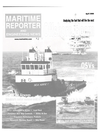
Charting The World Electronically
The advent of electronic chart technology has left ship and boat owners with an unprecedented tool to aid in safe and efficient navigation. But while the electronic advances have swept interest and headlines around the world, they have also created a considerable amount of confusion regarding, for example, when electronic charts can legally replace paper versions.
With the notion of clearing the air, MR/EN has spoken with one of the world's leading companies in the field, CMap, to discuss the ins and outs of new electronic chart technology.
Currently, ship owners are focusing on the availability of quality electronic chart data for ECDIS. C-Map, being the largest supplier of charts in digital format, has responded to the requirements by offering worldwide coverage on CD ROM. The data from C-Map is coded in proprietary System Electronic Navigational Chart (SENC), optimized for direct use by the onboard ECDIS computer. This format, dubbed CM93 by C-Map, has been adopted by many manufacturers of ECDIS systems (Please see Table l).
ENC & ECDIS It is imperative to note that only National Hydrographic Offices (HOs) can issue Electronic Navigation Charts (ENC) data as a paper chart replacement. HOs can, and do. subcontract work to commercial companies, but the HO is ultimately responsible for data quality control. Only when ENCs are displayed on a typeapproved ECDIS system can they replace paper charts.
The International Hydrographic Organization (IHO) has defined the ENC chart format specified in the S-57 Edition 3 (S- 57/3) product specification, which is a detailed format developed as a data exchange format to be used by HOs. It is not a format designed to be manipulated and displayed on a navigation screen, and for this reason the ECDIS Performance Standards accept that ENC data is compiled into an internal format in the ECDIS system, or in a SENC format. Thus, one of the more critical steps is ensuring the integrity of the data when compiling from ENC to SENC format. The presentation of nautical charts and symbols on a navigation system is defined by the IHO as well, in the S52 specification, which is also referred to in the ECDIS Performance Standards.
Partnerships C-Map, in effect, acts as a link between the HOs and the users of digital nautical charts, and the company is constantly developing new technology and services to achieve this goal. C-Map is not only working with HOs to digitize paper charts, but working with them also to develop their national ENC portfolios in S-57/3. C-Map developed the CM-93 Edition 3 (CM-93/3) format that fully complies with the S-57/3 format as defined by the IHO.
Data produced by C-Map is produced in CM-93/3 format, which is used by a number of system manufacturers as their SENC format. C-Map has developed software that compiles S-57/3 data in CM- 93/3 format. The compiler was typeapproved by DNV, to ensure that there is no loss or corruption of data in this process. This compiler is suppled to system manufacturers that use CM-93/3 as a SENC to enable their systems to read S- 57/3 data directly.
The CM-93/2 chart portfolio of 13,900 chart files produced by C-Map has been converted into the same CM-93/3 SENC format, but it can only be used as an aid to navigation. ECDIS systems that use CM- 93/3 have access to extensive chart coverage.
As ENC data becomes available, this will take priority over other data and be clearly recognized as official data when displayed, but unfortunately only limited ENC data is presently available.
Distributing charts in the SENC format means that the updating of charts can be carried out via the Internet, or remote access using a shipboard communications line. The SENC format, in effect, is a compressed format (approx. 1:5) in comparison to S-57/3, and additionally, no compression is required onboard.
Circle 137 on Reader Service Card
Read Charting The World Electronically in Pdf, Flash or Html5 edition of April 2000 Maritime Reporter
Other stories from April 2000 issue
Content
- Corsaire 13000 Embodies Integrated, Advanced Propulsion System page: 48D
- Jotun: Greening the trade in crude page: 8
- Financing Sources for U.S. Government Programs page: 14
- Deltamarin And Almaco Join Together page: 18
- ASRY Reports Prosperous 1999 page: 18
- A New View page: 20
- The Smokeless Solution Is Coming Over The Horizon page: 22
- Strategic Value Adding Purchasing page: 28
- DCR Optimistic About Future Of Offshore Drilling Sector page: 34
- Offshore Industry Leaders Invest Heavily In Safety Programs page: 36
- Electronic Engines Power New OSV Breed page: 40
- Angola And Canada Provide Projects For Smit Pioneer page: 40
- Rig Repowered At Houston Ship Repair page: 41
- Charting The World Electronically page: 44
- Reality Checked page: 45
- NoFire Technologies Helps Ships Meet SOLAS page: 48
- Is Diesel-Electric Propulsion the System for You? page: 50
- Drew Marine, MAN B&W Launch Redesigned Fuel Mill page: 52
- Austal Breaks 24-Hour Record page: 53
- PropExpert V. 4.2 Released page: 53
- GE To Supply Gas Turbines For IHI page: 54
- Jabsco Offers Oil Change Kit page: 54
- Calling All Mariners page: 56
- MTN, BT Hook-Up Cruise Ships To Cell Phone Network page: 59
- Norwegian Manufacturers Maintain Edge page: 60
- Leica Extends Its Influence In DGPS Arena page: 69
- ViaSat Ups Phase Two page: 69
- Encouraging best practice onboard using video and interactive media page: 73
- Blount Completes Dinner Vessel page: 74
- ACCL Offers New Chicago-Based Cruises page: 78
- Boatracs To Exclusively Distribute MarStar page: 78
- DNV Cleans Up With Celebrity's Millennium page: 79
- Transas Unveils GMDSS Simulator page: 85


